

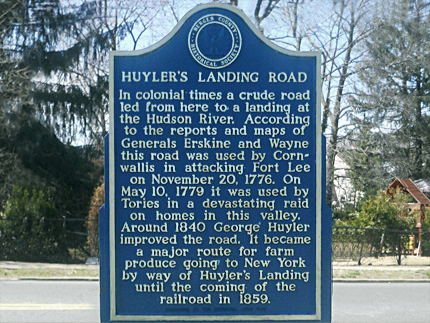
Huyler's Landing Road Marker
East Madison Ave. and County Rd.
Map / Directions to Huyler's Landing Road
Map / Directions to all Cresskill Revolutionary War Sites
This sign marks the site of Huyler's Landing Road, which was known at the time of the Revolutionary War as Lower Closter Landing Road. The road ran from here to a dock on the Hudson River called Lower Closter Landing, and later Huyler's Landing. The sign notes the road's use by attacking forces on two notable occasions during the Revolutionary War.
On November 20, 1776, British and Hessian troops under General Cornwallis crossed the Hudson River from New York City, disembarked at Lower Closter Landing, and traveled inland up the road. From here they turned south, traveling down what is now Tenafly Road in Tenafly, making their way towards the American troops encamped at Fort Lee. [1]
The raid the sign refers to actually occurred on May 9, 1779, not May 10. The raid was one of many conducted in Bergen County by Tories (Americans who remained loyal to the British during the Revolutionary War). This raid was particularly destructive. Among the casualties of the raid was 89-year-old Douwe Tallman, who died of bayonet wounds two days later; he is buried at Sautjes Tave's Begraven Ground Cemetery in neighboring Demarest. [2]

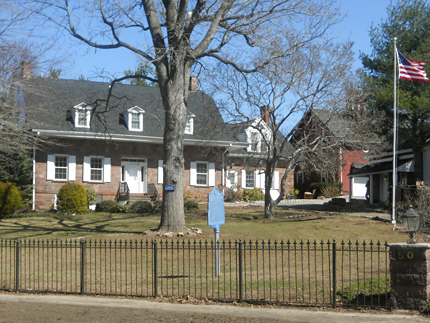
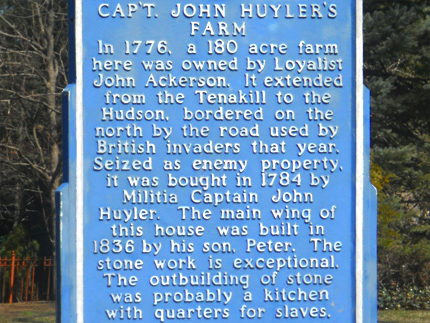
Site of Captain John Huyler's Farm
County Rd. and Linwood Ave.
Map / Directions to the site of Captain John Huyler's Farm
Map / Directions to all Cresskill Revolutionary War Sites
This house is a private residence.
Please respect the privacy and property of the owners.
Although this house was built in 1836, more than a half-century after the end of the Revolutionary War, the property has Revolutionary War significance. The Bergen County Historical Society plaque at the house explains that this property was part of a 180-acre farm which belonged to a Tory named John Ackerson. The property ran from the Tenakill Brook, which runs along just west of Piermont Road, to the Hudson River, about two miles to the east. Lower Closter Landing Road, later called Huyler's Landing Road (see above entry), was the northern border of the farm.
John Ackerson was one of many Tories in the Hackensack Valley area to have his property confiscated during the war by the state of New Jersey. The property was purchased after the war was over in 1784 by John Huyler, who served in the war as a captain in the Bergen County Militia. Huyler's own home had been burned in the May 9, 1779 Tory raid mentioned in the above entry. This house was built by John Huyler's son Peter in 1836. [3]

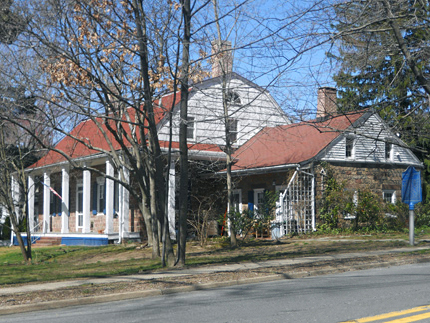
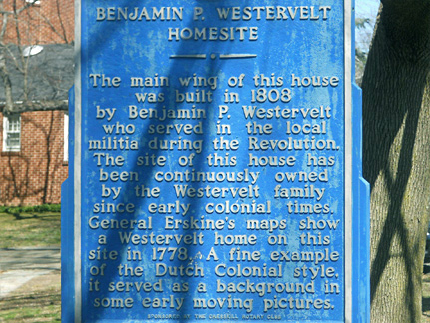
Benjamin P. Westervelt House
County Rd. and Westervelt Pl.
Map / Directions to the Benjamin Westervelt House
Map / Directions to all Cresskill Revolutionary War Sites
This house is a private residence.
Please respect the privacy and property of the owners.
Benjamin P. Westervelt served in the Bergen County militia in the Revolutionary War. He was captured several times by the British, and spent time in the Sugar House prison in New York City. The British occupied New York City for most of the war, and they converted buildings and ships into makeshift prisons which were notorious for their poor, overcrowded conditions and high mortality rate. Two sugar houses (used to refine sugar) were made into prisons. One of them, Livingston's Sugar House, which was located on Crown Street (now Liberty Street), became known as "The Sugar House" after the other ceased to be used as a prison in 1777.
Westervelt built the main wing of this house in 1808, twenty-five years after the Revolutionary War ended. However, the smaller wing may have been constructed as early as the 1770's. [4]

1. ^ For more information about Huyler's Landing as the site of the November 22, 1776 landing, see the Alpine page of this website.
For more information about the abandonment of Fort Lee by Continental troops and their subsequent retreat, see the Fort Lee page of this website.2. ^ Eric Nelsen, "The 1779 Closter Landing Raids," in Barbara Z. Marchant, ed., Revolutionary Bergen County - The Road to Independence (Charleston, SC: The History Press, 2009), 77-85.
• See the Demarest page of this website for more about Douwe Tallman and his gravesite.
3. ^ Information for this entry was drawn from:
• The Bergen County Historical Society sign at the property
• Adrian C. Leiby, Revolutionary War in the Hackensack Valley, The Jersey Dutch and the Neutral Ground, 1775 - 1783 (New Brunswick: Rutgers University Press) Page 206
▸Leiby provides a long list of Bergen County Tories who had their property seized, including John Ackerson.
He also writes, "When the commissioners began their inquisitions and published lists of Tories, Bergen County names seemed to outnumber by far those in all the rest of New Jersey, and almost all of the names listed in Bergen County were those from the Hackensack valley."• John Spring, et al." Cresskill, New Jersey Tercentenary Celebration (1964)
Available to be read as a PDF on the Borough of Cresskill website here
▸ On page 8, it states that Huyler "purchased these acres in 1784 for 1,658 pounds, or approximately $8,500, a high price for those days."
4. ^ Information about Benjamin P. Westervelt and the house was drawn from:
• Bergen County Stone House Survey - Individual Structure Survey Form for the Benjamin P. Westervelt House
Available as a PDF on the National Park Service /National Register of Historic Places website here.• John Spring. et al," Cresskill, New Jersey Tercentenary Celebration (1964) page 17
Available as a PDF on the Borough of Cresskill website hereInformation about The Sugar House and other New York prisons was drawn from:
• Edwin G. Burrows, Forgotten Patriots, The Untold Story of American Prisoners During the Revolutionary War (New York: Basic Books, 2008) page 23 - 24, and throughout